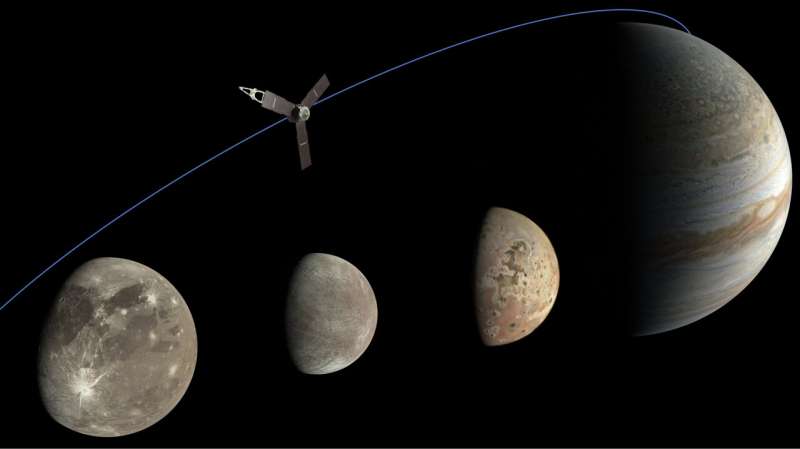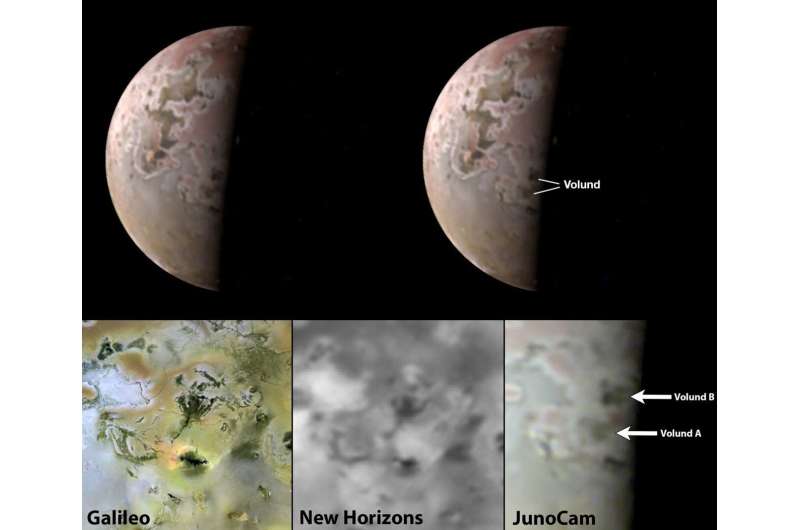This article has been reviewed according to Science X's editorial process and policies. Editors have highlighted the following attributes while ensuring the content's credibility:
fact-checked
trusted source
proofread
NASA's Juno is getting ever closer to Jupiter's moon Io

The spinning, solar-powered spacecraft will take another look of the fiery Jovian moon on July 30.
When NASA's Juno mission flies by Jupiter's fiery moon Io on Sunday, July 30, the spacecraft will be making its closest approach yet, coming within 13,700 miles (22,000 kilometers) of it. Data collected by the Italian-built JIRAM (Jovian InfraRed Auroral Mapper) and other science instruments is expected to provide a wealth of information on the hundreds of erupting volcanoes pouring out molten lava and sulfurous gases all over the volcano-festooned moon.
"While JIRAM was designed to look at Jupiter's polar aurora, its capability to identify heat sources is proving to be indispensable in our hunt for active volcanos on Io," said Juno Principal Investigator Scott Bolton of the Southwest Research Institute in San Antonio.
"As we get closer with each flyby, JIRAM and other instruments aboard Juno add to our library of data on the moon, allowing us to not only better resolve surface features but understand how they change over time."
Launched in 2011, the spinning, solar-powered spacecraft has been studying the Jovian system since 2016 and will begin the third year of its extended mission on July 31.
Io's Hot Spots
Slightly larger than Earth's moon, Io is a world in constant torment. Not only is the biggest planet in the solar system forever pulling at it gravitationally, but so are Io's Galilean siblings—Europa and the biggest moon in the solar system, Ganymede. The result is that Io is continuously stretched and squeezed, actions linked to the creation of the lava seen erupting from its many volcanoes.
During Juno's last flyby of Io, which occurred May 16, the JunoCam imager took a picture from 22,100 miles (35,600 kilometers) showing a smudge at the moon's Volund region, near the equator. Such smudges are smoking guns to planetary scientists.
"When I compared it to visible-light images taken of the same area during Galileo and New Horizons flybys (in 1999 and 2007), I was excited to see changes at Volund, where the lava flow field had expanded to the west and another volcano just north of Volund had fresh lava flows surrounding it," said Jason Perry of the University of Arizona's HiRISE Operations Center in Tucson. "Io is known for its extreme volcanic activity, but after 16 years, it is so nice to see these changes up close again."
During that same May 16 pass, JIRAM found a smoking gun of its own. Built by the Italian Space Agency, Agenzia Spaziale Italiana, the infrared imager was able to capture 125-mile-wide (202-kilometer-wide) Loki Patera, the largest volcanic depression on Io. At less than 6 miles (10 kilometers) per pixel, the JIRAM data reveals what could be an active volcano. The team hopes for another look with the next flyby.
"The data show the lava could be bubbling to the surface in the northwest portion and creating a lava lake to the south and east," said Alessandro Mura, co-investigator from the National Institute for Astrophysics in Rome. "Any volcanologist will tell you it is important to determine whether a lava lake has a stable source of material from an underground chamber. These data, and those we collect on upcoming flybys, will be crucial to understanding the kind of volcanism that is occurring at Io."

Young scientists engage Jupiter
On July 17, Bolton and other members of the mission met with 49 students and early career scientists from all over Europe at the University of Rome to attend a weeklong workshop on Juno's cutting-edge data on Jupiter and its moons.
"The contributions of the European scientific and engineering communities have been so fundamental for the success of our mission," said Bolton. "This is just a small way of giving back to the community that means so much to us. During the workshop, students and early career researchers got to work with members of the Juno science team to develop some exciting scientific projects based on our data. Based on what I saw and the enthusiasm of these young people, the future of planetary exploration is bright here in Europe."
Provided by Jet Propulsion Laboratory





















